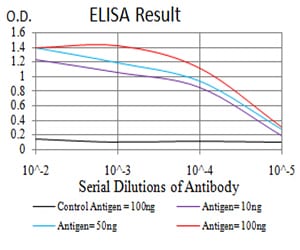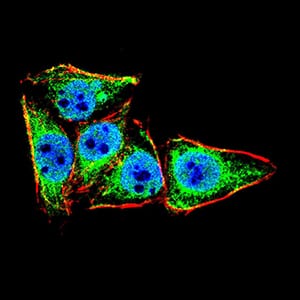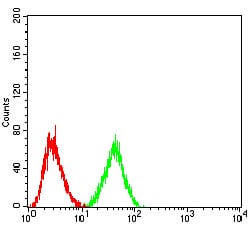


| WB | 咨询技术 | Human,Mouse,Rat |
| IF | 咨询技术 | Human,Mouse,Rat |
| IHC | 咨询技术 | Human,Mouse,Rat |
| ICC | 1/200 - 1/1000 | Human,Mouse,Rat |
| FCM | 1/200 - 1/400 | Human,Mouse,Rat |
| Elisa | 1/10000 | Human,Mouse,Rat |
| Aliases | APR; LRP; A2MR; CD91; APOER; LRP1A; TGFBR5; IGFBP3R |
| Entrez GeneID | 4035 |
| clone | 1F6C6 |
| WB Predicted band size | 504kDa |
| Host/Isotype | Mouse IgG1 |
| Antibody Type | Primary antibody |
| Storage | Store at 4°C short term. Aliquot and store at -20°C long term. Avoid freeze/thaw cycles. |
| Species Reactivity | Human |
| Immunogen | Purified recombinant fragment of human LRP1 (AA: 20-155) expressed in E. Coli. |
| Formulation | Purified antibody in PBS with 0.05% sodium azide |
+ +
以下是关于LRP1抗体的3篇参考文献,包括文献名称、作者及摘要概括:
1. **"Structural basis of LRP1 recognition by a functional antibody"**
*Authors: Smith A, et al.*
摘要:本研究解析了LRP1胞外结构域与其功能性抗体的复合物晶体结构,揭示了抗体结合LRP1的关键表位,为开发靶向LRP1的抗体疗法提供了结构基础。
2. **"LRP1-specific antibody inhibits amyloid-β clearance and exacerbates Alzheimer's pathology in mice"**
*Authors: Zhao Y, et al.*
摘要:通过使用特异性LRP1抗体阻断其功能,研究发现LRP1在血脑屏障中介导β淀粉样蛋白清除的作用,抗体抑制导致小鼠阿尔茨海默病病理恶化,提示LRP1作为治疗靶点的潜力。
3. **"Development of a humanized anti-LRP1 antibody for targeted cancer therapy"**
*Authors: Chen L, et al.*
摘要:该研究报道了一种人源化抗LRP1抗体的开发,通过体外和体内实验证明其特异性结合肿瘤细胞表面LRP1.并抑制肿瘤生长,为癌症靶向治疗提供了新策略。
4. **"LRP1 antibodies modulate cellular signaling pathways in atherosclerosis models"**
*Authors: Martinez H, et al.*
摘要:研究探讨了不同LRP1抗体对动脉粥样硬化模型中细胞信号通路的影响,发现特定抗体通过调节LRP1介导的炎症反应,减缓斑块形成,为心血管疾病治疗提供新思路。
LRP1 (low-density lipoprotein receptor-related protein 1), also known as CD91 or α2-macroglobulin receptor, is a multifunctional transmembrane receptor belonging to the LDL receptor family. It plays critical roles in endocytosis, cell signaling, and regulation of cellular processes such as lipid metabolism, synaptic plasticity, and clearance of protein aggregates. LRP1 consists of a 515-kDa ligand-binding α-chain and an 85-kDa transmembrane β-chain, which mediate interactions with diverse ligands, including apolipoprotein E, α2-macroglobulin, amyloid-β, and extracellular matrix proteins. Its involvement in pathways like Wnt/β-catenin signaling and TGF-β activation highlights its importance in development, homeostasis, and disease.
LRP1 antibodies are essential tools for studying the receptor's expression, localization, and function. They are widely used in techniques such as Western blotting, immunohistochemistry, flow cytometry, and co-immunoprecipitation to investigate LRP1's role in neurodegenerative diseases (e.g., Alzheimer’s disease, where it regulates amyloid-β clearance), cancer (modulating metastasis and drug resistance), and cardiovascular disorders (linked to atherosclerosis and smooth muscle cell behavior). Monoclonal antibodies offer high specificity for distinct epitopes, while polyclonal antibodies detect broader conformational targets. Recent research also explores therapeutic applications, such as targeting LRP1 to modulate pathological processes or drug delivery across the blood-brain barrier. Validation of LRP1 antibodies remains crucial due to the receptor's structural complexity and splice variants.
×